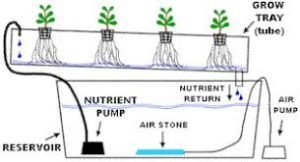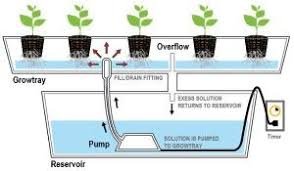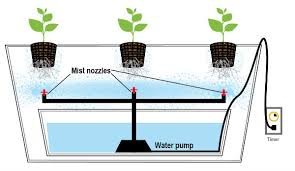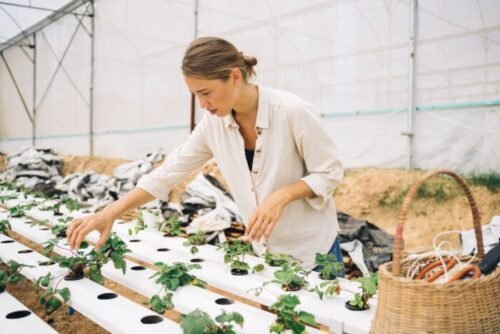Gardening methods have continued to evolve as technology advances and my gardeners have adopted to modern gardening techniques such as hydroponic gardening. These modern gardening techniques are usually challenging especially for beginners. What are hydroponic systems? How do they work? What are the best hydroponic plants to grow? These are key questions that this article seeks to answer and provide a definitive guide to hydroponic gardening.
What is hydroponics?
Hydroponics is the method of growing plants in a water-based solution with the key nutrients without using soil. An inert media/grow medium such as Rockwool, gravel or perlite is used to provide support to the growing plants.
In hydroponic gardening, plants are grown under a controlled environment and they grow faster and yield more compared to other traditional gardening methods. It’s for these reasons that the idea has gained a lot of popularity in the recent years and many gardeners around the globe have given it a trial.
A hydroponic system is used to accommodate plants, inert media and nutrient-rich water solution. Everything thing takes place in a hydroponic system and plants are closely monitored up-to maturity.
What Are The 6 Types Of Hydroponic Systems?
There are different types of hydroponic systems that one can use in hydroponic gardening. Let us look at the 6 most popular types of hydroponic systems.
6 Types of hydroponic systems
- Wick Hydroponic System
- Nutrient Film Technique (NFT)
- Deep Water Culture (DWC)
- Ebb and Flow (Flood and Drain)
- Drip Hydroponic System
- Aeroponics
Wick Hydroponic System
This type of hydroponic system is the most basic and has been for existence for more than a century now. It’s also known as passive hydroponics because it does not require water pumps to operate.

A wick is used to move nutrients and water into plants root zones. This can be something like a rope but for it to work effectively, it requires a good growing medium. Some of the best inert media that works perfectly with this type of hydroponic system include; perlite, coconut coir and vermiculite.
Wick hydroponic system uses a lot of water and nutrients compared to other systems and it’s ideal for small plants only. It’s one of the best hydroponic systems for beginners since it does not require technical expertise.
Pros of wick hydroponic systems
- Easy and faster to assemble
- Ideal for beginners and small plants
- Cost effective
Cons;
- Wick systems are not good for larger plants
- The plants may require high amount of water and nutrients than what the system is able to supply
- Package Includes: 30 pcs Net Pots, 30 feet self-watering capillary wick cord, and 30 pcs plant labels. With Orimerc self-watering wick to make DIY automatic self-watering planter pot, vacation self-watering system waterer for potted plants, orchid, or African Violet, auto wicking hydroponic device; Reusable plant labels to mark what type of seed you plant and to remind you what’s where and ideal for identifying seedlings or potted plants without getting in the way.
- Slotted Mesh Air Circulation Perfect for Orchid & Holding Growing Medium: net pots with slotted mesh open & airy design perfect for orchids. Great air flow & drainage make it almost impossible to over water or “wet feet”. The roots will have the air circulation they need. Sturdy, yet pliable, no rough edges and enough mesh & gaps with right amount of spacing for holding your expanded clay pellets in while letting plenty of water through. The soil does not fall out of the sides or bottoms.
- Wide Lip More Flexibility to Fit & Reusable: 3.2″ extra wide lip design on top makes it easy to fit & keep it in place & lends more flexibility to the hole-saw you use, as you don’t have to be as precise with your hole cutting. Rim is wide enough that they will not fall through the pre-drilled holes in the Styrofoam, grow beds or aquaponics tanks. 3 in netted cup pots with collar are heavy duty durable, therefore can be reused after you pick the plant.
- Net Pot for Hydroponic & Aquaponics: net cup pots works perfectly for hydroponic setup system, wide mouth Kratky quart mason jar insert, passive bucket Kratky method, indoor aquaponics garden, 5 gallon bucket, aquaponics tanks, automatic watering PVC pipe tube hydroponics gardening float system, aeroponics setup, container garden project, rain gutter grow system, cloning propagation system, Deepwater culture hydroponic, NFC DWC deep water culture rafts hydroponics kit, tower garden.
- Anywhere Year Round Provides Fresh Veggies: new growing methods with clay pebbles and rock wool to provide fresh delicious vegetables Year Round including winter, small herbs such as lettuce, tomatoes, parsley, peppers, basil, rosemary, strawberries, chives, cilantro, lavender lemon balm, oregano, peppermint, sage, tarragon, thyme, rocket salad, cress, spinach, mustard & carnivorous plants etc. Engraftment basket for greenhouse, window seal, enclosed porch, basement, deck, green house garden.
Last update on 2022-12-28 at 10:05 / Affiliate links / Images from Amazon Product Advertising API
Related; Best LED Grow Lights for Indoor Plants
Nutrient Film Technique (NFT)

NFT Hydroponic system is among the most popular systems that many gardeners use. Under Nutrient Film Technique (NFT), plants are grown in tubes that have a continuous supply of nutrient solution that run on the growing tube.
Upon reaching the end of the growing tube, the nutrient-rich water solution flows back into the reservoir for another recirculating system.
Plant are supported by small plastic net pots on the growing tube and they can therefore, grow to maturity without the use of any extra growing medium such as perlite or coconut coir. Plant roots are not completely submerged as compared to the deep water culture system.
Pros of NFT Hydroponic system;
- Plants roots are able to absorb enough oxygen and nutrient from the constantly flowing solution
- It can support many plants hence, it can be expanded to a large scale production
Cons;
- The system is prone to power outages and pump failure
- Roots are on the high risk of drying-up and rotting in case of total system failure
Deep Water Culture
Deep water culture is one of the easiest hydroponic systems for beginners. Also known as reservoir method, DWC operates by submerging plant roots in a nutrient solution.
An air pump is then used to oxygenate the nutrient solution therefore, preventing the roots of the plants from drowning (something that is commonly experienced by the beginners).

The plants are placed into the net pots on top of the reservoir that you use to hold nutrient-rich water solution. Hydroponic growing medium are also added to the net pots to provide extra support for the plants.
Pros of Deep Water Culture
- Easy to setup and operate especially for beginners
- Cost effective and low-maintenance
Cons;
- It can only work best with small plants
- Not suitable for plants with long maturity periods
- 8PCS PP Buckets: Our DWC hydroponic system is equipped with 8 buckets made of high-quality PP material for long-lasting use. Each plant bucket features a 5″ basket and can hold up to 5 gallons, large enough to help you grow multiple plants at a time.
- Powerful Air Pump & Air Stone: Air Pump Voltage: AC120V 60HZ. Air Pump Power: 10W. Air Flow: 25 L/min. The air pump and air stone used for the deep water culture provide plenty of oxygen to each bucket via air hoses, helping to build a healthy root system faster.
- User-friendly Design: The recirculating deep water culture system is water-saving, labor-saving, and high-yielding. It features tight seals to ensure no leaks and inline check valves to avoid reverse flow. Besides, there is a water level device on the side of the bucket to allow you to observe the water condition at any time.
- Complete Hydroponic System: The DWC bucket system is easy to use with complete accessories, including 8 planting buckets, 12 m air hose, 1 set of connectors, 8 water level devices, 8 check valves, 8 air stones, 1 air pump, clay pebbles, and 1 instruction manual.
- Wide Application: You can enjoy fresh vegetables and fruits with our DWC system. It is suitable for the grow tent, greenhouse, garden, balcony, office, home, and other indoor or outdoor places without soil.
Last update on 2022-12-27 at 10:22 / Affiliate links / Images from Amazon Product Advertising API
EBB & FLOW (Flood and Drain Method)

The flood and Drain method uses a timer to supply nutrients to the plant roots at particular intervals. A tray and net pots are used to hold the plants and it’s placed on top of a reservoir.
The tray is therefore, filled with a growing medium and nutrient-rich solution is “flooded” in the tray at different intervals per every day.
The number of intervals depends on the size of your plants, growth cycle, air temperature and your plants water requirements.
After “flooding”, the excess nutrient solution drains back into the reservoir via gravity. It’s thereafter oxygenated by the air pump and air stone waiting for the next flooding cycle.
An effective flood and drain system requires a reservoir below the tray, net pots, nutrient-rich solution, growing medium, water pump, and a timer so as to schedule the flooding cycle.
Pros of Ebb & Flow System;
- Economical in terms of water nutrients and electricity
- It can be customized to suit your specific needs
Cons;
- Plant roots are on the high risk of drying up in case of a system failure
- More growing medium is needed to support the plants
Drip system (Recovery & Non-recovery)
Drip hydroponic systems are simple and easy to operate. A timer is fitted to control the submersible pump and when it’s switched ON, the pump moves the nutrient solution and it’s dripped to the plant roots via a drip line.

In recovery system, the excess nutrient solution is tapped back into the reservoir for the next cycle while for non-recovery system, the excess nutrient solution is not trapped back into the reservoir.
Slow draining grow medium such as coconut coir and Rockwool are ideal for this type of hydroponic systems.
Pros of drip hydroponic systems;
- Economical in terms of nutrients and energy
- Affordable compared to other hydroponic systems
Cons;
- Drip line are on the high risk of clogging
- Frequent fluctuation of PH and nutrient levels
- High level of nutrient waste in non-recovery system
Aeroponics
Aeroponic hydroponic systems employs the technology of misting the plant roots with nutrient solution at given intervals instead of “flooding” as seen with other systems. Aero-gardens uses this method to provide frequent supply of nutrients to suspended plants.

A fine spray nozzle is needed so as to make the spray work easier and more effective. A timer is used to control the misting cycle although aeroponic systems require more misting cycles compared to other hydroponic systems.
Pros of aeroponics;
- Effective use of nutrient solutions
- Plant roots enjoy more oxygen compared to the sub-merged root systems
Cons;
- Roots can dry up more faster in case of system breakdown
- A bit expensive compared to other systems
- 30% Faster than soil cultivation: iDOO hydroponic growing system comes with a large water tank, a full-spectrum LED grow light, and a circulation system that keeps water fresh. The hydroponic setup and lighting system allow plants to grow up to 3X faster and healthier than soil cultivation, resulting in rapid growth and bountiful harvests.
- 8 Pods, up to 15″ tall: iDOO Hydroponics Growing System ensures that your plants grow in a soilless and pollution-free condition. The 8-pod design allows you to grow 8 plants (up to 15″) at a time, including herbs, vegetables, fruits, or flower varieties, which makes it easier to reap a bigger indoor harvest with this indoor garden.
- 2 Grow modes with 16H full sunlight: Features vegetable and fruit modes for different planting. The vegetable mode enhances the blue light to make the plants leafy, and the fruit mode enhances the red light to make the plants bloom and fruit. 16H light is provided automatically per day so you don’t have to worry about turning the lights on and off.
- Quiet Smart Watering System: This Hydroponic growing system is designed with a water circulation system, increasing oxygen in water for better root growing. Activate the pump to go into a cycle of 30 mins on/30 mins off with super low noise.
- Perfect gift for family: iDOO hydroponic growing system makes it possible to grow fruits and vegetables all year round, which is an ideal gift for yourself, families and friends.
Last update on 2022-12-28 at 10:19 / Affiliate links / Images from Amazon Product Advertising API
What are the benefits of hydroponics?
As a gardener, you might be asking yourself whether this modern gardening technique has any value compared to the conventional gardening methods.
Right?
It’s with no doubt that this soil-less gardening method is a game changer to farmers because, you will enjoy a full-year supply of plants and vegetables that are organically grown within a small grow area.
In order to understand the value that this modern gardening method brings to the sustainable food production, let’s discuss in details some of the advantages of hydroponics gardening.
Advantages of hydroponics
Faster maturity & increased yields
Under hydroponic gardening, plants are grown under a controlled environment. All the necessary nutrients and light is provided so that the plants grow under optimal conditions. Therefore, plants are able to grow faster and yield more compared to the traditional gardening.
Grow tent kits are used to secure the hydroponic systems from excessive external heat and other harmful factors thus, giving the plants an ample time and condition to thrive.
The system uses less water
As a result of re-circulation cycles, plants grown via hydroponic gardening use only 10-20% of water unlike open field system where plants use up to 80% of water supply.
Therefore, the systems are economical and one can grow different plants and herbs even in dry and urban areas where there is little water supply.
No soil required
Land has always been a key factor of food production but with hydroponics, you don’t require soil to enjoy full-year supply of fresh vegetables and herbs. In addition, the kind of soil available might not be ideal for the plants that you want to grow due to nutrient deficiency any diseases.
In hydroponics, plants are supplied with specific nutrients and growing medium to provide support as an alternative to soil. Therefore, you can practice hydroponic gardening even in urban areas (through vertical gardens) and enjoy bumper harvest without necessarily owning land.
Nutrients are used efficiently
Plants are grown using specific nutrients that they require at different stages of growth. As a gardener, you must first of all assess the nutritional requirements of your plants so as to supply them with the needed nutrients at specific stages.
A reservoir tank is used to store the excess nutrient-rich water solution for recycling which prevents wastage. Therefore, hydroponics gardening makes maximum utilization of nutrients compared to the conventional gardening methods.
Plants are grown under a controlled environment
In hydroponic gardening, the gardener is able to control the prevailing climatic conditions in the system.
You can adjust the temperature levels, humidity and light intensity to suit different growth stages of your plants.
With this customization, you can therefore, enjoy full year supply of fresh vegetables and herbs regardless of external climatic-conditions.
Less labour input
Due to its soil-less nature, hydroponics gardening eliminates any presence of weed and pests on the systems. This translates to low labor demand compared to the open-field method where one has to create time for cultivating, tilling and fumigation.
Hydroponic gardening saves time and one is able to enjoy organically grown plants that are healthy and free from any pesticides.
High growth rate
Under an indoor grow system, plants are grown in a controlled environment. Therefore, they are protected from pests, and other potential hazards that may interfere with growth.
As a result, plants are able to grow and mature faster compared to traditional methods where plants are affected by the prevailing external conditions.
Disadvantages of Hydroponics
High Initial cost
Although hydroponics gardening is more productive than open-field gardening, it requires some capital to setup the system. For beginners, it’s advisable to start with simple system that are quite affordable and one can upgrade to more sophisticated ones.
Recurring operating cost
Nutrient solutions keeps on depleting and they require to be added from time to time. The systems also require electricity in order to function properly which results to extra operating cost.
Technical know-how is required
Hydroponic systems requires close and regular monitoring. As a gardener, you are required to understand how different components operates.
Upon system installation, you are required to observe and maintain optimal growth conditions for plants at different stages.
High risk of system failure
Most hydroponic systems use electricity to operate the entire system. A timer is used to pump nutrient solution to the plant roots at various intervals while grow lights are used to supply light.
Any unexpected power outage may affect the normal functionality of the system. If there are no immediate backup power plans, the flow of nutrients to the plant roots is likely to be interfered with and this may lead to your plants drying up.
Therefore, it’s important to closely monitor the system and repair any system failure to avoid any damage.
Hydroponic Plants
Which plants that one can grow through hydroponics?
This is a very common question that many people ask. Not every plant can do well under hydroponics. Plants such as potatoes, onions and sweet potatoes are not fit for hydroponic gardening.
If you are aspiring to venture into hydroponic gardening, the following are some of the plants that can do well when grown hydroponically.
- Tomatoes
- Strawberry
- Flowers
- Lettuce
- Herbs
- Green Pepper
- Cannabis

